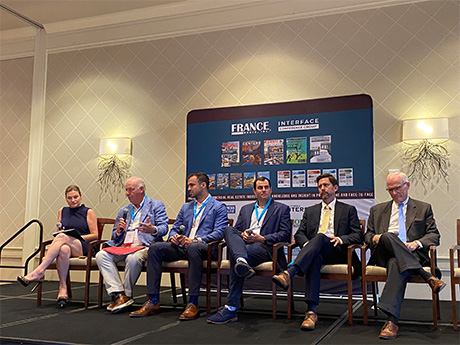By Taylor Williams
Raising equity to get new projects to pencil out is, at the moment, immensely challenging in the Houston multifamily market.
Although debt providers are showing a willingness to lend at favorable leverage ratios despite the fact that Houston has had healthy levels of new apartment deliveries in recent months, meeting the required returns that equity providers demand is challenging due to ever-increasing construction and operating costs. As a result, some projects are fizzling, even if they feature good locations or present compelling stories to capital providers.
Editor’s note: InterFace Conference Group, a division of France Media Inc., produces networking and educational conferences for commercial real estate executives. To sign up for email announcements about specific events, visit www.interfaceconferencegroup.com/subscribe.
This finding was the consensus among a panel of five Houston multifamily owners who were asked to identify the single-biggest challenge to new development in the current environment. The panelists gave their remarks at the inaugural InterFace Houston Multifamily conference, which took place on June 17 at The Briar Club and was attended by some 200 industry professionals. Crystal Kingsbury, director of marketing and business development at Anchor Construction, served as the panel moderator.
“The equity guys are really tough right now,” said Stacy Hunt, executive director at Greystar and the first panelist to tackle the question. “They’re concerned about their risk versus reward and going in [to the deal], they would prefer to see close to a 7 percent return on cost, and that’s tough [to guarantee].”
Hunt noted that relatively fewer multifamily properties in Houston have traded hands, meaning there are fewer data points and comparable examples with which to convince equity providers that their returns can be met. He also pointed out that many developers in Houston are merchant builders; their business plan calls for them to sell the property upon stabilization. Underwriting exit cap rates and other metrics on those projects as part of selling them is difficult when equity sources are sidelined, Hunt said.
Parker White, vice president of development at The NRP Group, a Cleveland-based developer, agreed that raising equity is no easy feat in the current climate and attributed some of the struggle to oversupply.
“We have some submarkets in which [renters] are being offered two to three months of free [rent] concessions,” White said. “That makes it nearly impossible to determine how much of that rent is real and how much is just make believe. We’re optimistic that supply will drop off while demand remains strong throughout, so delivering a project in late 2026 or early 2027 will be the perfect time to see rent growth. But getting equity on board with that story can be difficult.”
Hunt estimated that the country would add about 450,000 new apartments in 2025 but that deliveries would fall off sharply to about 250,000 units in 2026. Houston’s volume of new deliveries should drop from about 17,000 units this year to 9,000 in 2026, he added. His numbers further underscored White’s implication that the stringent requirements of equity providers were understandable since so much new supply has been added recently.
Matt Bronstein, managing director at Houston-based BHW Capital, then spoke to the creative ways in which developers can sometimes work around the hesitancy of equity partners. Seeing as equity sources have the luxury of being choosy, Bronstein said that his company focuses on identifying aspects of its projects that stand out from the competition, whatever form that may take.
“The [requirement of a] 7 percent yield on cost is very real,” he said. “We spend a lot of time working with our architects and contractors to build those competitive advantages that will attract a couple more tenants paying a little more rent and generating that additional return. We evaluate ways to create additional income streams within the property while delivering a higher-quality project at a reasonable cost.”
Ricardo Rivas, CEO of AOG Living, a local developer formerly known as Allied Orion Group, echoed the other panelists’ expectations that paces of multifamily rent growth and absorption will soon be more favorable to owners. Seeing some shifts in basic trends and metrics like these should both help loosen some equity purse strings and make it easier for those groups to hit their numbers. Until then, however, underwriting realistically to the rate of return that most equity groups want is difficult, even with ample debt in the market, Rivas said.
“Loans are plentiful, but when you underwrite deals and try to get them to a 7 [percent rate of return] but it’s not a real 7, the restriction there is the debt service coverage,” he explained. “You’re not getting the 65 or 70 percent loan-to-cost [ratio] that you were hoping for on the debt; you’re getting 50 or 55 percent loan-to-cost. The additional equity has to be raised, and the deal just doesn’t work because you have to put in more money.”
Lance Gilliam, managing partner at Concentric Community Advisors, was the final panelist to address the subject. His company provides financial consulting services to mixed-income and affordable housing developers, so Gilliam discussed the issue of equity gaps and return thresholds from that perspective.
“We’re all up here talking about yield, and there’s really only three ways to affect yield: increase income, decrease expenses or lower the cost to develop,” he said. “Our firm can increase yield on mixed-income and affordable housing [properties] by lowering expenses, which creates more opportunity for affordability. Our challenge is taking limited tools and using them to increase return so that we construct a high-quality product that’s affordable to a broad group of people, without the stigma that’s historically come along with affordable housing.”


